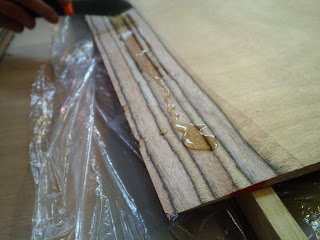We have started are build of the 3.5 meter dory that we are building as the main project of the semester. This boat was designed by Christopher John Scott Lovegrove, who also is one of the tutors at this school. We have 6 weeks, 3 days per, to complete this project. It will be challenging because no one on our team has ever built a boat before.
We were able to choose are team from the members of the class which is good because we already know each other well and we know the strengths and weaknesses of the team. A good team consists of many attributes, communication, hardwork, and knowledge being the biggest three. Communication: we must be able to understand what the other person is thinking and discuss parts of the build to arrive at the best possible solution. Hardwork: if people are lazy and/or don't show up to class then the boat will not be completed on time. This is costly for both the rest of the team and for the future because it can mean that the costs of the finished craft increase. Knowledge: we must understand how to build the craft. We have a set of plans and access to the autoCAD drawing but we must understand the steps needed to effectively build and not waste time.

 We had these spiling planks that we tacked up against either the garboard or strake topsides (in this case the garboard). On these planks we can measure up to the bottom and down to the chine line for each station and also make a note of the stem, the transom and midship frames. we would write down on the plank itself what that distance is and then take that plank over to a piece of cardboard. Once we have the plank on the card board we can use a straight edge and mark out the distances from each of the stations. Then we used a fairing batten, in the exact same way we used them for the bottom or for when we first lofted our first boat. After we got a fair line and have made note of all of the points, transom, stem and midship frames, we cut out the cardboard and transfer it to the sheet of ply. Once again the plywood is shorter than the length that we need and so we must again scarf the boards together. When we cut out the boards we chose to put the garboard scarfs aft and the strake scarfs forward so all of the pressure is not all all for scarfs at the same time. Additionally we made sure that when it came time for gluing the scarfs up that the joint, if it broke, would break into the boat. We saved the off cut of wood from this ply and used it for other jobs.
We had these spiling planks that we tacked up against either the garboard or strake topsides (in this case the garboard). On these planks we can measure up to the bottom and down to the chine line for each station and also make a note of the stem, the transom and midship frames. we would write down on the plank itself what that distance is and then take that plank over to a piece of cardboard. Once we have the plank on the card board we can use a straight edge and mark out the distances from each of the stations. Then we used a fairing batten, in the exact same way we used them for the bottom or for when we first lofted our first boat. After we got a fair line and have made note of all of the points, transom, stem and midship frames, we cut out the cardboard and transfer it to the sheet of ply. Once again the plywood is shorter than the length that we need and so we must again scarf the boards together. When we cut out the boards we chose to put the garboard scarfs aft and the strake scarfs forward so all of the pressure is not all all for scarfs at the same time. Additionally we made sure that when it came time for gluing the scarfs up that the joint, if it broke, would break into the boat. We saved the off cut of wood from this ply and used it for other jobs.


















.jpg)

